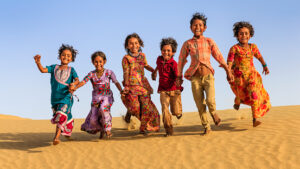Since hemoglobin thresholds for anemia are currently based on data collected over 50 years ago in Caucasian adults, the WHO is calling for a re-examination of these thresholds. One suggested approach is to define anemia by age- and sex-appropriate hemoglobin cut-offs—namely the lowest 5% in an otherwise healthy population. These data, however, are scarce in low- and middle-income countries. In 2019, the Comprehensive National Nutrition Survey (CNNS) collected 49,486 blood samples from children and young adults aged 1-19 years in India. After excluding individuals with deficiencies in iron, folate, vitamin B12, and retinol, those with inflammation or variant hemoglobins, and any individuals with a history of smoking, 8,087 samples were used to determine the range of hemoglobin in both healthy girls and boys aged 1-19 years. Based on a hemoglobin cut-off in the lowest 5% to define anemia, the cut-offs were usually 1-2 g/dL lower at all ages compared to current WHO thresholds. This difference was most pronounced in children of both sexes 1-2 years old and in girls 10 years or older. The prevalence of anemia using the CNNS thresholds was 10.8% compared to 30.0% using these WHO thresholds in the entire sample. The CNNS prevalence of anemia in Indian children may more accurately reflect the true burden of anemia and may explain why aggressive public health measures have not decreased anemia in recent years. Additional population-based surveys should be completed in other low- and middle-income countries to determine suitable thresholds for anemia.
References:
- Sachdev HS, Porwal A, Acharya R, Ashraf S, et al. Haemoglobin thresholds to define anemia in a national sample of healthy children and adolescents aged 1-19 years in India: a population-based study. The Lancet 2021
- World Health Organization Newsroom. April 2021. WHO technical meeting on considerations to determine haemoglobin concentrations to define anaemia in the lifecycle.

